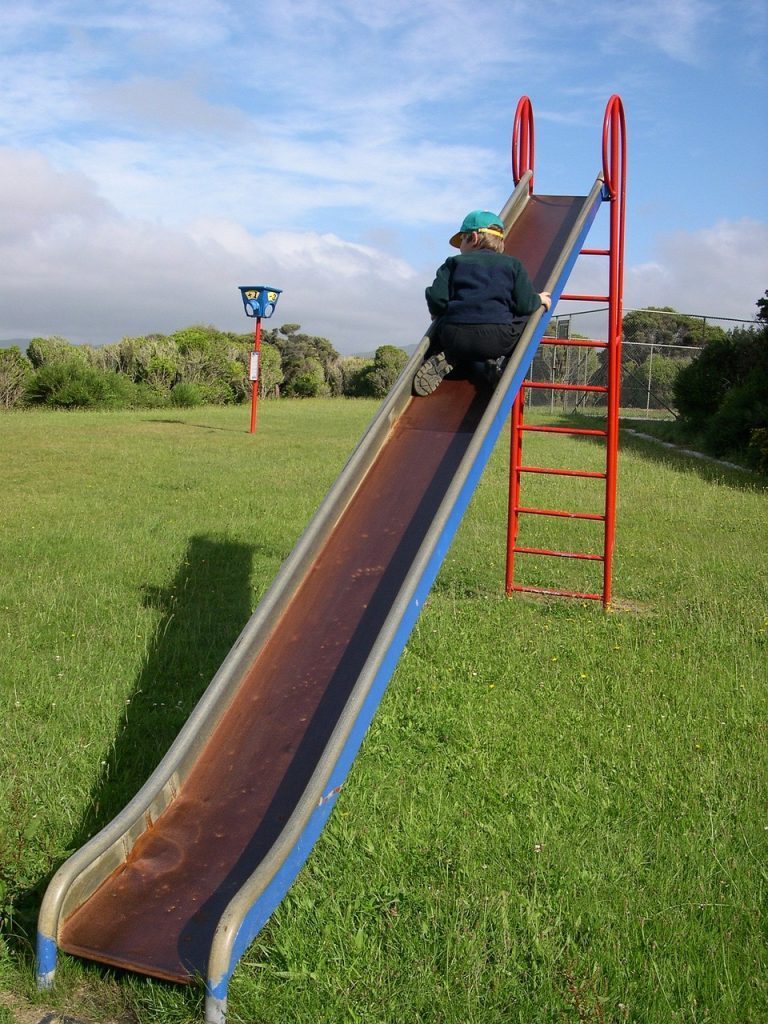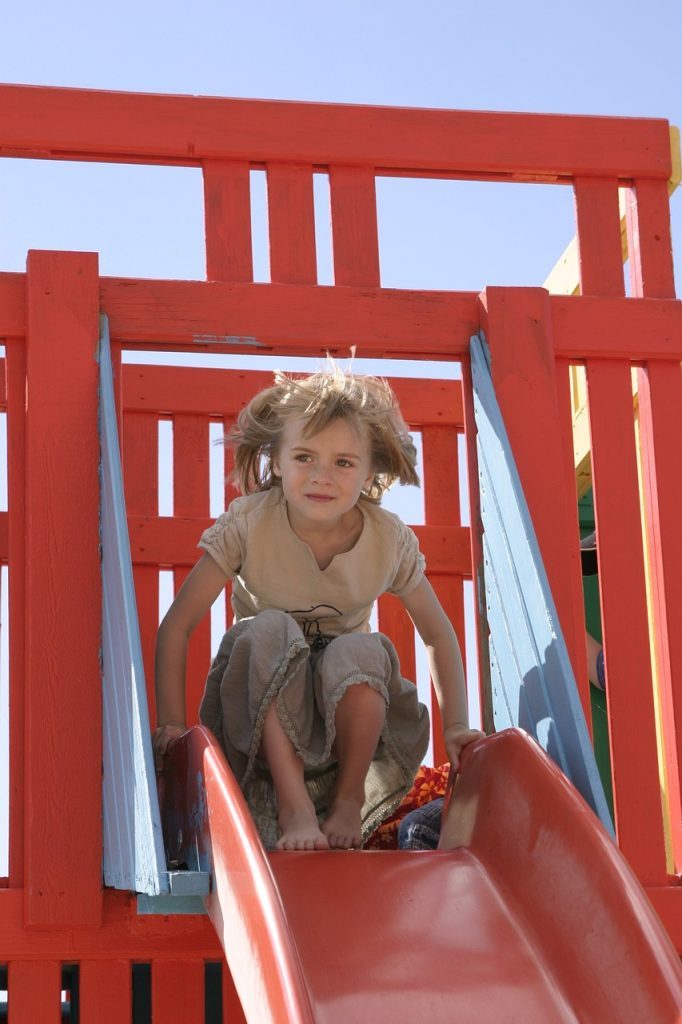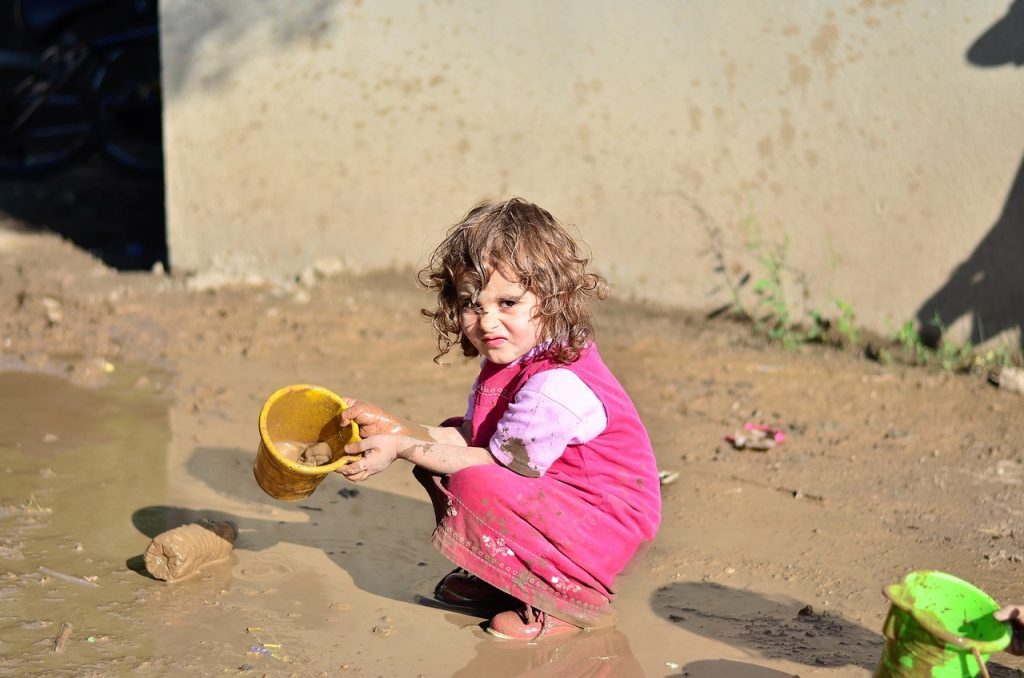
Table of Contents
I dug back into my childhood memories for these 4 kid-approved ways to use a slide that don’t involve sliding. I know they’re kid-approved because they were part of my childhood in the 70s, and I’ve seen kids engage in them every decade since. While kid-approved, they may not be adult-approved.
Sometimes, cast-in-stone ideas of right and wrong ways to use materials or equipment cloud adult judgment. They rule that not using the slide ‘right’ is a playground crime.
Such rules hinder child-led learning. If you limit kids to only sitting upright and going down one person at a time, you’re preventing a wide range of other ways to slide, as well as the activities below.
A slide is nothing more than a loose part, which Simon Nicholson described as a variable in an environment with which people can interact. Limiting the way slides can be used makes them less loose.
With appropriate supervision to ensure safety, using a slide for play that’s not sliding-focused is 100% developmentally appropriate.
Real Play
Speaking of play, according to Peter Gray, real play meets these conditions:
- Play Is Self Chosen And Self Directed
- Play Is Activity In Which Means Are More Valued Than Ends
- Play Is Imaginative, Non-literal, Mentally Removed In Some Way From “Real” Or “Serious” Life
- Play Has Structure, Or Rules, Which Are Not Dictated By Physical Necessity But Emanate From The Minds Of The Players
- Play Involves An Active, Alert, But Non-stressed Frame Of Mind
All the ways to use a slide that don’t involve sliding should be part of real play, not some planned activity kids don’t choose and direct for themselves.
Ways To Use A Slide That Don’t Involve Sliding
I have to preface this list to clarify that these ways of using a slide that don’t involve sliding may involve a small amount of actual sliding. Still, it’ll be an ancillary activity, not the primary focus. Let’s delve into those kid-approved ways to use a slide that don’t involve sliding:
Climbing
Adults fret about it; kids love it. Climbing is almost the exact opposite of sliding. It is an excellent form of heavy work, any activity that pushes or pulls against the body or involves carrying. It builds muscle strength and control as well as confidence.

Dramatic Play
Combine a slide with a big hunk of uninterrupted okay time and some interesting loose parts, and dramatic play happens.
Back in my day, the big slide in our backyard anchored lots of dramatic play. I remember it serving as a submarine, a covered wagon, a pirate ship, a spaceship, a castle, a family car, the Batcave, the Fortress Of Solitude, the Orca, the General Lee, an X-wing fighter, a cave, a temperamental pet dinosaur, and more.

STEM Learning
A slide is an inclined plane, one of the six classic simple machines. Technically, it’s a pair of inclined planes; the slide section is one, and the stairs are the other. In slide-based STEM play, kids experiment with making things go up and down the slide, usually non-human things. In my personal childhood experience, things like water, sand, mud, paint, toy cars, sticks, tires, bowling balls, seed pods, baby dolls, plastic cows, soggy shredded newspaper, and honey.
This play may also involve a not insignificant amount of crashing and smashing. Arranging an army of toy dinosaurs and farm animals at the bottom of the slide before rolling a bowling ball down, for example.
Of all the ways to use a slide that don’t involve sliding, this category is likely the messiest and loudest.
It might look like chaos, but in that chaotic-looking play and exploration, kids are learning about gravity, friction, material properties, the scientific method, problem-solving, patterns, predictions, measuring, estimating, mass, motion, energy transfer, force, cause-and-effect relationships, fluid dynamics, air resistance, structural stability, innovation, creativity, and more.
Such play is worth the mess, is more organized and less chaotic than it appears at first glance, and leads to much learning if you take the time to see it.
Sensory Play
One of the primary focuses of early learning settings should be sensory integration since the 8 sensory systems are a brain’s primary information sources. To thrive, children need well-integrated sensory systems.
These systems build robust connections with their brain through active engagement with the world. Young children learn when they are in motion.
Yet, children have never been more sedentary than they are today.
Sliding and the ways to use a slide that don’t involve sliding engage all the sensory systems and feed the brain they are connected to an abundance of information.
In many early learning settings, sensory play tends to focus on the sense of touch, specifically hand-based touch, as kids are allowed to mess with some mud, a plastic bin full of gravel, or a tabletop spotted with globs of shaving cream.
One way to embrace the slide as a platform for sensory play is to let kids interact with the mud, shaving cream, and all the other concoctions on the slide’s surface. This makes it more likely those materials will come in contact with toes, legs, arms, and faces–a much more dynamic tactile experience.
Another way to embrace slide-based sensory play is to realize that all the sliding, climbing, STEM play, and dramatic play are also sensory learning activities. They give the 5 sensory systems we learned about in elementary school a workout but also call upon the vestibular system, proprioceptive system, and interoceptive system.
I’m not suggesting you smear honey on the slide like my buddies and I did back in the day, but bowling balls, tires, water, and the like add a variety of slide-based sensory experiences that benefit kids.

Ways To Use A Slide That Don’t Involve Sliding Wrap-Up
The 4 ways to use a slide that don’t involve sliding laid out above are actually doorways to hundreds and hundreds of different ways kids can use slides as loose parts in their play and exploration.
Contribute content to Playvolution HQ
Brought to you by Explorations Early Learning
Browse Trainings

Post Author
Jeff Johnson is an early learning trainer, podcaster, and author who founded Explorations Early Learning, Playvolution HQ, and Play Haven.

Leave a Reply